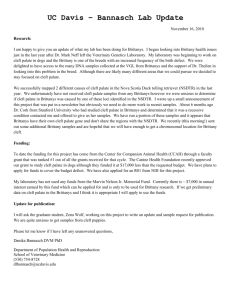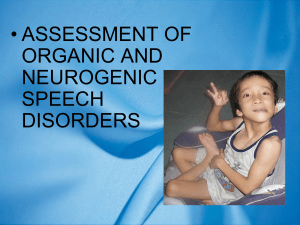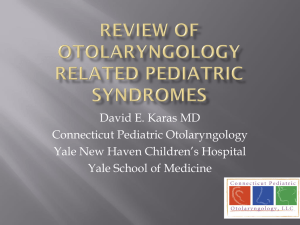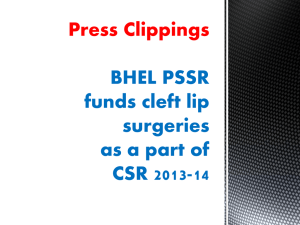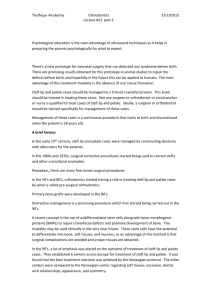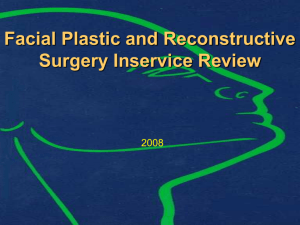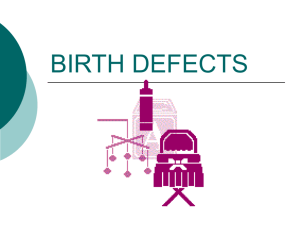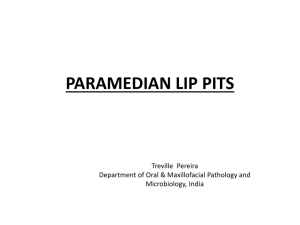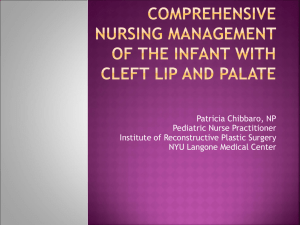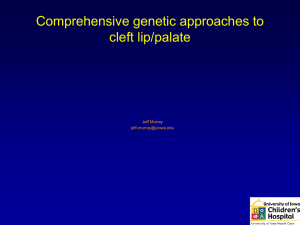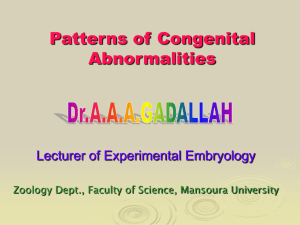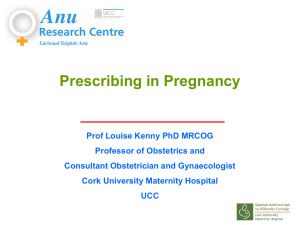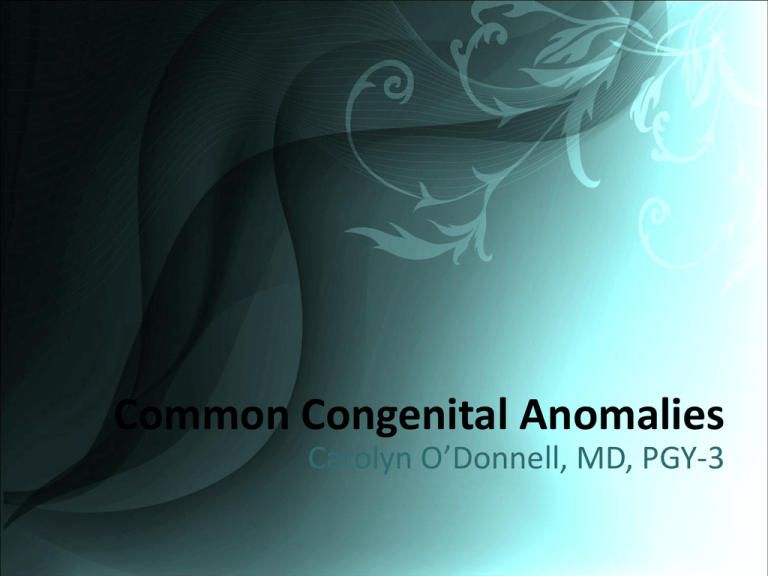
Common Congenital Anomalies
Carolyn O’Donnell, MD, PGY-3
Newborn Exam
•
•
•
•
•
•
•
•
•
Fontanelle
Eyes/lacrimal ducts
Nares
Lips/palate/tongue/
frenula
Ears- pits/tags
Clavicles/neck
Brachial pulses
Chest
Heart
•
•
•
•
•
•
•
•
Lungs
Abdomen
Femoral pulses
GU- testes/female
genitalia
Hips
Extremities
Back/spine
Skin
Head
Enlarged
fontanelle
Hair- swirls/white forelock
Eyes- congenital cataracts, extra folds,
hyper/hypotelorism, upslant/downslant
Choanal atresia
Ear pits/tags, position/rotation
Cleft palate/lip
Prominent frenula/tongue tie
Red Reflex
• Rule out opacities between the cornea and
the retina
• Congenital glaucoma: can see large eyes,
excess tearing and cloudy corneas. This
condition can be clinding
• An infant with consistently white pupils might
have a retinoblastoma tumor
Red Reflex
Tongue Tie (Ankylogossia)
Neck and Chest
•
•
•
•
•
•
Cystic hygroma
Thyroglossal duct cyst
Branchial cleft cyst
Pectus excavatum
Extra mamillary tissue (3rd nipple)
Heart murmur- congenital heart disease
Thyroglossal Duct Cyst
Pectus Excavatum
What syndrome is this?
Extranumerary nipple
Abdomen and GU
• Omphalocele/gastroschesis/umbilical hernia
• Scaphoid abdomen- ?congenital diaphragmatic
hernia
• Femoral pulses- aortic coarctation
• Undescended testes
• Virilized female
• Fistulas, hypospadia/epispadias, imperforate
anus, Hirschprung’s
• Posterior urethral valves (no urinating)
Imperforate Anus
Hypospadias
Virilized female
Extremities and Skin
•
•
•
•
•
•
Congenital Hip dysplasia
Extra digits
Single palmar crease
Clubbed foot
Congenital nevi
Hemangiomas
Club Foot
hemangioma
Cleft lip/palate
• Incidence: about 1 in 600 live births
• Cleft lip with or without cleft palate
• Syndromic: associated with another syndrome.
Syndromic cleft lip/palate is more common in
males
• Nonsyndromic: isolated finding, not associated
with any particular syndrome. Non syndromic
tends to be equal between males and females.
• Consider submucous cleft palate with bifid uvula
Causes
• Multifactorial: combination of hereditary and
environmental factors involved in growth and
development
• Interference with normal development- within the 1st
few months of development
• Medications such as phenytoin, steroids, retinoids
(Vitamin A derivatives)
• Alcohol, hypoxia and dietary deficiencies have been
implicated
• Both single and multiple genes
Cleft lip/palate
Syndromes
•
•
•
•
•
DeGeorge/velocardiofacial/22q deletion
Pierre Robin malformation sequence
Apert syndrome
Crouzon syndrome
Treacher-Collins
Complications
• Feeding problems
• Eustacian tube dysfunction secondary to
abnormal muscle placement -> serous
otitis/middle ear disease/chronic ear
infections -> hearing problems
• Speech problems
• Dental problems
• Team approach needed: medical/surgical,
dental, speech and hearing
Treatment
• Surgical repair- usually by plastic surgery- can
affect maxillofacial growth pattern
• Timing of surgery controversial- often in 2 stages.
One commonly used plan involves early soft
palate repair at age 6 months, followed by hard
palate repair at age 6 years. Others involve
complete repair at a later age.
• Involvement with ENT, speech therapy, following
hearing tests, dental/orthodontic specialists,
social supports.
Undescended Testicle (cryptorchidism)
• Occurs in 3-4% of full term newborns
• More common in premature infants- transinguinal
migration occurs at 28-40 weeks gestation (under
hormonal control)
• Often the testicle will descend by the time the infant is
9 months old- prevalence is 1% at 1 year of age
• If there’s no descent by 1 year of age, this warrants
further workup
• One can ask the family to check at home in a warm
bath due to retractile testis (due to cremasteric reflex)
Causes
•
•
•
•
•
•
•
•
Increased incidence in prematurity
Increased risk with:
Small for gestational age
Low birth weight
Maternal exposure to estrogen early in pregnancy
Twin
Sibling with cryptorchidism
Conditions associated with low intra-abdominal
pressure
Cryptorchidism
Cryptorchidism
• Complications• Infertility (increased risk with time in abdomen)
• Increased risk for testicular cancer- approximately
40x normal
• If neither testicle palpable, endocrine and genetic
testing warranted to determine true sex
• Ultrasound may be helpful to identify the location
of the testicle- sometimes not present at all
• If partially descended, exam should be followed
closely to make sure fully descends
Treatments
• Often surgical (orchiopexy) though some medical
treatments have been tried including
testosterone and HCG
• Surgery performed by general surgeon or
urologist- usually between 6 and 12 months of
age
• Surgical correction many decrease the risk of
cancer though it is still significantly elevated.
• Another benefit of surgery is more easily
identifiable if tumor/mass. Also decreased
infertility.
Ear pits and tags
• There is an association between ear anomalies
and hearing loss. Audiologic evaluation is
recommended for any ear anomaly
• Multiple ear anomalies may suggest a kidney
problem as well as there is an association and
many syndromes contain anomalies in both
systems.
• Renal Ultrasound is not recommended if
isolated pit or tag
Preauricular Ear Pit
Ear Tag
Preauricular Ear Tag




